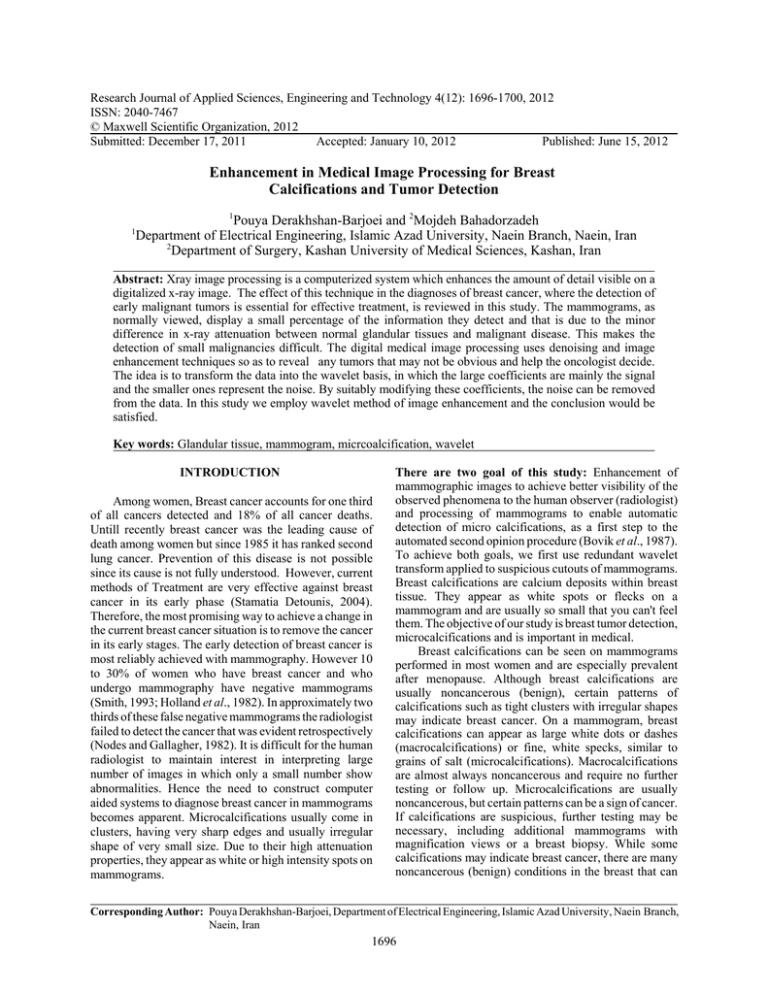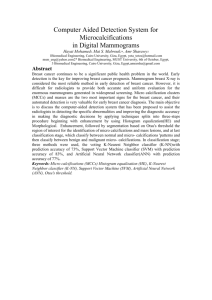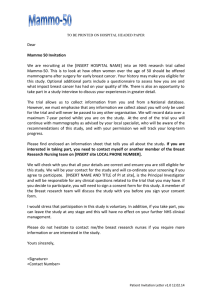Research Journal of Applied Sciences, Engineering and Technology 4(12): 1696-1700,... ISSN: 2040-7467
advertisement

Research Journal of Applied Sciences, Engineering and Technology 4(12): 1696-1700, 2012
ISSN: 2040-7467
© Maxwell Scientific Organization, 2012
Submitted: December 17, 2011
Accepted: January 10, 2012
Published: June 15, 2012
Enhancement in Medical Image Processing for Breast
Calcifications and Tumor Detection
1
1
Pouya Derakhshan-Barjoei and 2Mojdeh Bahadorzadeh
Department of Electrical Engineering, Islamic Azad University, Naein Branch, Naein, Iran
2
Department of Surgery, Kashan University of Medical Sciences, Kashan, Iran
Abstract: Xray image processing is a computerized system which enhances the amount of detail visible on a
digitalized x-ray image. The effect of this technique in the diagnoses of breast cancer, where the detection of
early malignant tumors is essential for effective treatment, is reviewed in this study. The mammograms, as
normally viewed, display a small percentage of the information they detect and that is due to the minor
difference in x-ray attenuation between normal glandular tissues and malignant disease. This makes the
detection of small malignancies difficult. The digital medical image processing uses denoising and image
enhancement techniques so as to reveal any tumors that may not be obvious and help the oncologist decide.
The idea is to transform the data into the wavelet basis, in which the large coefficients are mainly the signal
and the smaller ones represent the noise. By suitably modifying these coefficients, the noise can be removed
from the data. In this study we employ wavelet method of image enhancement and the conclusion would be
satisfied.
Key words: Glandular tissue, mammogram, micrcoalcification, wavelet
INTRODUCTION
Among women, Breast cancer accounts for one third
of all cancers detected and 18% of all cancer deaths.
Untill recently breast cancer was the leading cause of
death among women but since 1985 it has ranked second
lung cancer. Prevention of this disease is not possible
since its cause is not fully understood. However, current
methods of Treatment are very effective against breast
cancer in its early phase (Stamatia Detounis, 2004).
Therefore, the most promising way to achieve a change in
the current breast cancer situation is to remove the cancer
in its early stages. The early detection of breast cancer is
most reliably achieved with mammography. However 10
to 30% of women who have breast cancer and who
undergo mammography have negative mammograms
(Smith, 1993; Holland et al., 1982). In approximately two
thirds of these false negative mammograms the radiologist
failed to detect the cancer that was evident retrospectively
(Nodes and Gallagher, 1982). It is difficult for the human
radiologist to maintain interest in interpreting large
number of images in which only a small number show
abnormalities. Hence the need to construct computer
aided systems to diagnose breast cancer in mammograms
becomes apparent. Microcalcifications usually come in
clusters, having very sharp edges and usually irregular
shape of very small size. Due to their high attenuation
properties, they appear as white or high intensity spots on
mammograms.
There are two goal of this study: Enhancement of
mammographic images to achieve better visibility of the
observed phenomena to the human observer (radiologist)
and processing of mammograms to enable automatic
detection of micro calcifications, as a first step to the
automated second opinion procedure (Bovik et al., 1987).
To achieve both goals, we first use redundant wavelet
transform applied to suspicious cutouts of mammograms.
Breast calcifications are calcium deposits within breast
tissue. They appear as white spots or flecks on a
mammogram and are usually so small that you can't feel
them. The objective of our study is breast tumor detection,
microcalcifications and is important in medical.
Breast calcifications can be seen on mammograms
performed in most women and are especially prevalent
after menopause. Although breast calcifications are
usually noncancerous (benign), certain patterns of
calcifications such as tight clusters with irregular shapes
may indicate breast cancer. On a mammogram, breast
calcifications can appear as large white dots or dashes
(macrocalcifications) or fine, white specks, similar to
grains of salt (microcalcifications). Macrocalcifications
are almost always noncancerous and require no further
testing or follow up. Microcalcifications are usually
noncancerous, but certain patterns can be a sign of cancer.
If calcifications are suspicious, further testing may be
necessary, including additional mammograms with
magnification views or a breast biopsy. While some
calcifications may indicate breast cancer, there are many
noncancerous (benign) conditions in the breast that can
Corresponding Author: Pouya Derakhshan-Barjoei, Department of Electrical Engineering, Islamic Azad University, Naein Branch,
Naein, Iran
1696
Res. J. Appl. Sci. Eng. Technol., 4(12): 1696-1700, 2012
cause calcifications to
calcifications include:
C
C
C
C
C
C
C
C
C
form.
Causes
of
breast
Breast cysts
Cell secretions or debris
Ductal carcinoma in Situ (DCIS)
Fibroadenoma
Mammary duct ectasia
Mastitis
Previous injury to the breast
Previous radiation therapy for cancer
Skin (dermal) or blood vessel (vascular) calcification
Mammograms are initially enhanced by either
increasing the contrast of suspicious area or by removing
background noise. Various mathematical methods are
then applied to detect the individual tumors depending on
whether the tumor appears as a micro calcification
cluster or a mass, in mammography the interesting
characteristics of an image are malignant masses,
microcalcifications and skin thickening of which the last
two are said to be indirect signs of malignancy (Abeloff
et al., 2008; Adam et al., 2008).
DETECTION OF MICROCALCIFICATIONS
Currently research is being concentrated on the
detection of microcalcifications in mammograms since
this is the first indication of the presence of breast cancer.
The pre-processing step consists of two main techniques
which are used individually or together. The first deals
with enhancing the contrast of suspicious area in the
image while the second technique involves the removal of
background noise from the image. The favored method of
image enhancement of mammograms in the removal of
background noise while preserving the edge information
of suspicious areas in the images. This can be achieved
using three different methods:
C
C
C
Selective averaging schemes
Median filtering
A modification of median filtering
Selection of median filter: Median filtering has been
found to be very powerful in removing noise from 2-D
signals without blurring edge (Stamatia Detounis, 2004).
This makes it particularly suitable for enhancing images.
To apply median filtering to a digital picture, we replace
the value at a pixel by the median of the values in a
neighborhood of the pixel. Two dimensional median
filters can be defined for arbitrary sizes and shapes of
filter windows W(i, j), such as line segmenta, squares,
circles and crosses. The edge preservation power of the
standard median filter is not sufficient for enhancing
mammogram images due to the fuzziness of the
boundaries of suspicious areas. A modification of the
filter selective median filter was defined by (Lai et al.,
1989; Rosenfeld and Kak, 1982). The main idea of the
median filter is to run through the signal entry by entry,
replacing each entry with the median of neighboring
entries. The pattern of neighbors is called the "window",
which slides, entry by entry, over the entire signal. For 1D
signals, the most obvious window is just the first few
preceding and following entries, whereas for 2D (or
higher-dimensional) signals such as images, more
complex window patterns are possible (such as "box" or
"cross" patterns). Note that if the window has an odd
number of entries, then the median is simple to define: it
is just the middle value after all the entries in the window
are sorted numerically. For an even number of entries,
there is more than one possible median. For a window W
(i, j) centered at image coordinates (i, j) the output of the
selective median filter is:
Xij = Median {Xrs : (r, s) m N(I, j) and | Xrs – Xij | <
T}(1)
where (i, j) m Z2, N (i, j) is the area in the image covered
by window W (i, j) and T is a threshold.
Wavelet expansion and techniques: (John et al., 1997)
developed a method for identifying clinically normal
tissue in digitized mammograms is used to construct an
algorithm for separating normal regions that may contain
isolated calcifications. Research into the detection of
microcalcifications using primary wavelet transform has
been carried out by and parkin, McLeod (1996).
This technique was designed to replace the FFT (Fast
Fourier Transform) method as it was found to be simpler
and more efficient. The first step is to decompose the
image with a wavelet expansion that yields a sum of
independent images, each containing different levels of
image detail. A Fast Fourier Transform (FFT) is an
efficient algorithm to compute the Discrete Fourier
Transform (DFT) and its inverse. An FFT computes the
DFT and produces exactly the same result as evaluating
the DFT definition directly; the only difference is that an
FFT is much faster. The DFT is defined by the formula:
N 1
Xk
xne
i 2 k
n
N
k 0,..., N 1
(2)
n0
This decomposition is repeated to further increase the
frequency resolution an the approximation coefficients
decomposed with high and low pass filters and then
down-sampled. This is represented as a binary tree with
nodes representing a sub-space with a different timefrequency localisation.
When calcifications are present, there is strong
empirial evidence that only some of the image
components are necessary for detecting a deviation from
1697
Res. J. Appl. Sci. Eng. Technol., 4(12): 1696-1700, 2012
g[n]
2
Level 3
coefficients
g[n]
g[n]
g[n]
X[n]
2
h[n]
2
Level 1
coefficients
2
2
h[n]
2
Level 2
coefficients
Fig. 1: A 3 level filter bank
normal. (Ted and Nicolas, 1998), presented an approach
for detecting microcalcifications in digital mammograms
employing wavelet based sub band image decomposition.
A three level filter bank is shown in Fig. 1. The
microcalcifications appear in small clusters of few pixels
with relatively high intensity compared with their
neighboring pixels. These image features can be
preserved by a detection system that employs a suitable
image transform which can localize the signal
characteristic in the original and the transform domain.
The sequence of N complex numbers x0, ..., xN-1 is
transformed into the sequence of N complex numbers X0,
..., XN-1 by the DFT according to the formula:
N 1
X k xn e
2 i
kn
N
k 0,..., N 1
(3)
n0
where i is the imaginary unit and e-2Bi/N is a primitive N'th
root of unity.
It is computationally impossible to analyze a signal
using all wavelet coefficients, so one may wonder if it is
sufficient to pick a discrete subset of the upper halfplane
to be able to reconstruct a signal from the corresponding
wavelet coefficients. One such system is the affine system
for some real parameters a>1, b>0. The corresponding
discrete subset of the halfplane consists of all the points
("m , n "m b)with integers m, n 0 Z. The corresponding
baby wavelets are now given as:
Rm,n(t) = a - m / 2R(a - mt -nb).
A sufficient condition for the reconstruction of any
signal x of finite energy by the formula:
x (t )
x ,m , n . m , n (t )
mZ n Z
(4)
is that the functions {Rm, n : m, n 0 Z} form a tight frame
of Lp function space L2 (R).This subspace in turn is in
most situations generated by the shifts of one generating
function R 0 L2 (R):
(t ) 2 sin c (2t ) sin c(t )
sin(2t ) sin(t )
t
(5)
with the (normalized) sinc function.
PROPOSED METHODS AND RESULTS
Wavelet theory provides a powerful framework for
multiresolution analysis and it can be used for texture
analysis. This study can help physicians to improve the
minimal invasive operation for a breast tumor. Typical
experiment about breast region segmentation is shown in
Fig. 2. (Michael and Alexei, 2004).
Our proposed method using Wavelet decomposition
for two times the result of frequency components of
mammogram image is shown in Fig. 3 and Fig. 4.
For a mammogram processed with our method at
different levels of wavelet analysis , the final image of
component yielding as shown in Fig. 5.
Our original mammogram image and final result of
our method as described is shown in Fig. 6. We can
compare them and see how the microcalcification
detection in clear, so the threshold setup and noise
reduction for each image should be set intelligently.
In medical images, noise suppression is a particularly
delicate and difficult task. A tradeoff between noise
reduction and the preservation of actual image features
has to be made in a way that enhances the diagnostically
relevant image content. We evaluate two-dimensional
denoising procedures using medical test images corrupted
with additive Gaussian noise. Our results, using the
peak-signal-to-noise ratio as a measure of the quality of
denoising, show that the proposed method outperforms
well.
1698
Res. J. Appl. Sci. Eng. Technol., 4(12): 1696-1700, 2012
Fig. 2: (a) Original mammogram; (b) Enhanced image; (c) Extracted breast region; (d) Contour overlain on a LOG-attenuated version
of (a); (e) Micro calcification in breast; (f) White specks
Fig. 3: Four images of the first step of decomposition from
original mammogram image
Fig. 4: Four images of the second step of decomposition from
mammogram image
1699
Res. J. Appl. Sci. Eng. Technol., 4(12): 1696-1700, 2012
REFERENCES
Fig. 5: Image of finalcomposition of the levels
(a)
(b)
Fig. 6: (a) Original mammogram image; (b) Microcalcification
detected image of our method
CONCLUSION
In our method a digital medical image processing
uses denoising and image enhancement techniques to
reveal any tumors that may not be obvious. The method
of wavelet thresholding has been used extensively for
denoising medical images. The idea is to transform the
data into the wavelet basis, in which the large coefficients
are mainly the signal and the smaller ones represent the
noise. By suitably modifying these coefficients, the noise
can be removed from the data. We employ wavelet
method of image enhancement and the results show
good performace. The proposed technique in the
diagnoses of breast cancer enhanced by either increasing
the contrast of suspicious area or by removing
background noise. The method of wavelet thresholding,
mathematical method, is applied to detect the individual
tumors depending on whether the tumor appears as a
microcalcification cluster or a mass, in mammography the
interesting characteristics of an image are malignant
masses, microcalcifications and skin thickening of which
the last two are said to be indirect signs of malignancy.
Adam, A., A.K. Dixon, R.G. Grainger and D.J. Allison,
2008. Grainger and Allison's Diagnostic Radiology:
A Textbook of Medical Imaging. 5th Edn., Elsevier
Churchill Livingstone, Philadelphia.
Abeloff, M.D., J.O. Armitage, J.E. Niederhuber,
M.B. Kastom and W. Gillies, 2008. Cancer of the
Breast. Abeloff's Clinical Oncology. 4th Edn.,
Churchill Livingstone Elsevier, Philadelphia.
Bovik, A.C., T.S. Huang and D.C. Munson, 1987. The
effect of median filtering on edge estimation and
detection. IEEE Trans. Pattern. Anal. Machine Intell.
181-194.
Holland, R., M. Mrvunae, J.H. Hendricks and
B.V. Bekker, 1982. So-called interval cancers of the
breast: Pathologic and radiologic analysis of
Sixty-four cases. Cancer, 49: 2527-2533.
John, J.H., R.D. Stanely and D.K. Cullers, 1997. Richard
stauduhar, member ieee and laurence p, clarke
member ieee. Multiresolution statistical analysis of
high-Resolution digital mammograms. IEEE T. Med.
Imag., Vol: 603-515.
Lai, S., X. Li and W.F. Bischof, 1989. On techniques for
detecting circumscribed masses in mammograms.
IEEE T. Med. Imag., 8(4): 377-386.
McLeod, G., G. Parkin, First Canadian Conference on
computer and Robot Vision, 1996. Automatic
detection of clustered microcalcification using
wavelets. Third international workshop on digital
Mammography, Chicago.
Michael, A.W. and S. Alexe, 2004. Segmentation of the
Breast Region in Mammograms using Snakes. pp:
385-392.
Nodes, T.A. and N.C. Gallagher, 1982. Median filters:
Some modifications and their properties. IEEE Trans.
Acoust., Speech Signal Processing, Vol. ASSP-30,
Oct.
Rosenfeld, R. and A.C. Kak, 1982. Digital Picture
Processing. New York Academic, New York.
Stamatia Detounis, M.D., 2004. Computer-Aided
Detection and second reading utility and
implementation in a high-volume Breast clinic. Appl.
Radiol., 33(9): 8-15.
Smith, R.A., 1993. Epidemiology of breast cancer”
syllabus: 79th Scientific Assembly of the
Radiological society of North America, pp: 21-33.
Ted, C.W. and B.K. Nicolas, 1998. Detection of Micro
calcifications in digital mammograms using wavelets.
IEEE Transaction on medical Imaging, pp: 498-505.
1700





